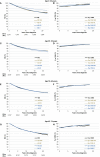Complete prevalence and indicators of cancer cure: enhanced methods and validation in Italian population-based cancer registries
- PMID: 37346072
- PMCID: PMC10280813
- DOI: 10.3389/fonc.2023.1168325
Complete prevalence and indicators of cancer cure: enhanced methods and validation in Italian population-based cancer registries
Abstract
Objectives: To describe the procedures to derive complete prevalence and several indicators of cancer cure from population-based cancer registries.
Materials and methods: Cancer registry data (47% of the Italian population) were used to calculate limited duration prevalence for 62 cancer types by sex and registry. The incidence and survival models, needed to calculate the completeness index (R) and complete prevalence, were evaluated by likelihood ratio tests and by visual comparison. A sensitivity analysis was conducted to explore the effect on the complete prevalence of using different R indexes. Mixture cure models were used to estimate net survival (NS); life expectancy of fatal (LEF) cases; cure fraction (CF); time to cure (TTC); cure prevalence, prevalent patients who were not at risk of dying as a result of cancer; and already cured patients, those living longer than TTC at a specific point in time. CF was also compared with long-term NS since, for patients diagnosed after a certain age, CF (representing asymptotical values of NS) is reached far beyond the patient's life expectancy.
Results: For the most frequent cancer types, the Weibull survival model stratified by sex and age showed a very good fit with observed survival. For men diagnosed with any cancer type at age 65-74 years, CF was 41%, while the NS was 49% until age 100 and 50% until age 90. In women, similar differences emerged for patients with any cancer type or with breast cancer. Among patients alive in 2018 with colorectal cancer at age 55-64 years, 48% were already cured (had reached their specific TTC), while the cure prevalence (lifelong probability to be cured from cancer) was 89%. Cure prevalence became 97.5% (2.5% will die because of their neoplasm) for patients alive >5 years after diagnosis.
Conclusions: This study represents an addition to the current knowledge on the topic providing a detailed description of available indicators of prevalence and cancer cure, highlighting the links among them, and illustrating their interpretation. Indicators may be relevant for patients and clinical practice; they are unambiguously defined, measurable, and reproducible in different countries where population-based cancer registries are active.
Keywords: Italy; cancer cure indicators; cure fraction; cure prevalence; prevalence; survival; time to cure.
Copyright © 2023 Toffolutti, Guzzinati, De Paoli, Francisci, De Angelis, Crocetti, Botta, Rossi, Mallone, Zorzi, Manneschi, Bidoli, Ravaioli, Cuccaro, Migliore, Puppo, Ferrante, Gasparotti, Gambino, Carrozzi, Stracci, Michiara, Cavallo, Mazzucco, Fusco, Ballotari, Sampietro, Ferretti, Mangone, Rizzello, Mian, Cascone, Boschetti, Galasso, Piras, Pesce, Bella, Seghini, Fanetti, Pinna, Serraino, Dal Maso and AIRTUM Working Group.
Conflict of interest statement
The authors declare that the research was conducted in the absence of any commercial or financial relationships that could be construed as a potential conflict of interest.
Figures






References
-
- Bray F, Colombet M, Mery L, Piñeros M, Znaor A, Zanetti R, et al. . Cancer incidence in five continents, vol. XI. In: IARC sci publ no. 166. (Lyon, France:International Agency for Research on Cancer; (2017).
LinkOut - more resources
Full Text Sources
Miscellaneous

